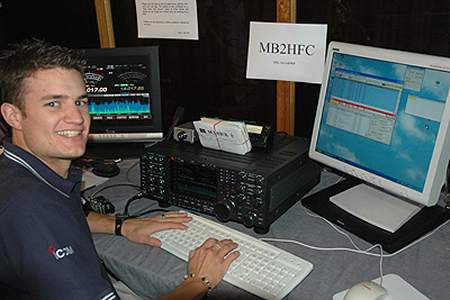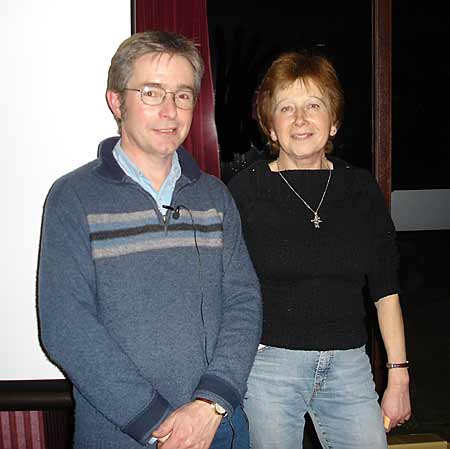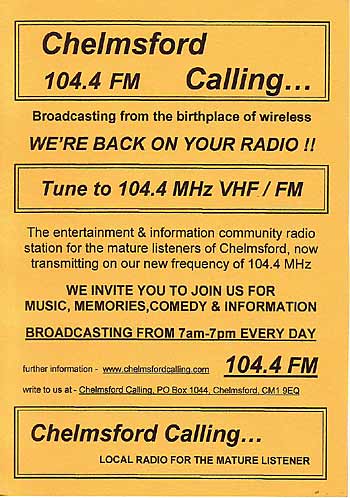Alan started his presentation by telling us that it had started as a talk to the local Rotary Club on what people do for a living, but as Amateur Radio had been a prominent part of his life he decided to include it. He had been a Radio Amateur since 1963 and is now a Telecoms Consultant. He said the definition of an IT consultant was one who borrowed your watch, told you the time, and charged you for the privilege. He promised not to charge us for his advice however. His company at the moment, deals with running projects, radio systems, dealing room IT, mobile and ship communications, designing and project managing public area networks, the relocation of offices; reorganising and re-cabling of their structures.
His professional work started in 1963 when he was a "Y in T" (Youth in Training as were a number of CARS Members ) with the GPO Post Office Telephones. Because of his interest in Radio, he was allocated to the PO Tower on Microwave Radio Maintenance, at that time a brand new building at 620 feet high including its 30 ft. tower at the top. At times he had to climb this to change the aircraft warning lights, not a job most of the staff relished even though the view over London from this point was stunning. On one occasion, the view included a completely circular rainbow.
He started in Amateur radio with a crystal set and progressed as most of us did in those days, through one, and then two or three valve sets. In 1963 he passed the RA exam and was allocated G8AQO. He said others did not look on his pass with a great deal of friendliness, as a B Licence was thought to have been a usurping of the full licence (without the Morse qualification for an A). He joined the Paddington Club and took part in a lot of their Field Day events; he showed us pictures of his van, the aerials, and a jury reflector for a 70 cms Yagi, using a hubcap from a Riley 1500 car.
In 1969 he moved career from the Post Office to the Home Office who were advertising for wireless technicians. In this job he was involved with communications for the Police, Fire and Civil Defence as well as the development of the dreaded Radar speed devices. The Marconi unit he illustrated and dealt with only went to 80mph initially, but was soon modified to bring it into line with more everyday traffic. He also showed pictures taken by the early speed cameras and told us of their snags. In 1973, still with the Home Office he moved to develop the Police National Computer Network (PNC); possibly the last national computer project to be delivered on time and on budget. In 1973 the PNC held details of the registration marks of 20,million vehicles and details of ownership 200,000 stolen or suspect vehicles and coded fingerprints of up to 3million people, all this could be called up in 5 to 8 seconds and was regularly checked.
He finally left the Civil Service and joined LOGICA; he worked on defence projects for RAF Communications. He was accepted by the IEE and felt he could now call himself an Engineer and was assigned to Arranco in Saudi Arabia.
After some 40 years he still keeps an interest in Amateur radio and took the Morse test in 2002. He was allocated the callsign M0DDC, but he still keeps G8AQO. His main interest today is QRP Morse activity and collecting old radios. One example he brought with him, a 3-valve battery and accumulator job in very good condition. He also spends his spare time with partaking in the SOTA activities and regaled us with a few of his experiences. His preferred rig at present, is an FT 817 with extra battery pack and a very neat foldable aerial which he demonstrated. It has a 15mm copper boom and three wire elements using plastic wall fixings as insulators and element supports (very neat light and clever.) Alan gave us a run through on the rules of Summits on the Air and was sorry that no "Marilyns" or the like were in Essex. The closest were Kent or the Dichling Beacon in Sussex.
Thank you Alan for a most enjoyable and varied run down on your professional and Amateur activities.
Tony Gilbey G4YTG.
Another superb evening scheduled by CARS Programme Secretary, Martyn, G1EFL.
February Meeting - Mark, M0DXR presented the FT5XO Kerguelen DXpedition.
Deep in the heart of the southern ocean, inside the Antarctic Convergence, lies a belt of far swept islands. One of the more remote is an island named Kerguelen. The Microlite Penguins DXpedition Team (so called because they travelled light) visited the island in 2005 with the aim of making thousands of radio contacts with other hams around the world. Mark, M0DXR, one of the team members, presented a slide presentation telling the story of the FT5XO Kerguelen DXpedition followed by a profesionally made DVD of the trip.

Many Club Members & visitors came along to learn of this amazing remote place, and hear the pile ups from this extrememly rare DXCC!
Thank you Mark for an excellent presentation & for agreeing to do it at such short notice.
January Meeting - CARS Triple Decker!
Chairman John, G8DET opened the meeting and welcomed Members, Partners & the many Visitors to this rather unusual Meeting. They were encouraged to purchase a Raffle Ticket (or two).
Part 1 Contests by Steve, G4ZUL
Steve introduced himself as G4ZUL and CARS Contest Manager. He said that he appreciated that CARS was not really a Contest Club but thought that Field Day could be resurrected. He asked the audience for their opinion - the response was a guarded "Yes".

RSGB National Field Days are in June (CW) & September (SSB). Dr Geoff Bowles has given permission for the aerial farm to be on the field used as a car park during Sandford Mill Open Days.
Steve had a small list of volunteers and equipment needed and suggested leaving a list near the door so that Members could add their names as they signed-in for a Club Meeting.
Steve said he would Register for the restricted section of the contests which would limit operating to 12 hours for the CW contest in June and 24 hours for the SSB contest in September.
He said he would like to do a follow-up presentation nearer the day - this was agreed.
CARS Triple Decker, Part 2 Electric Power Supply by Brian G3CVI
Brian said he had a controversial subject to discuss - however he hoped the message would be taken seriously as has been seen in a report by Ofgen recently.
In 1987, 11 nuclear power stations provided 11% of the countries total capacity of 46,000 MWatts. During the past 2 years a number of Magnox Nuclear Stations, including Berekley (Glos), Bradwell (Essex) both commissioned in 1962 & 250 MWatts each, and several coal-fired stations have been shut-down. Dungeness A (Kent), commissioned in 1964 & 550 MWatts & Sizewell A (Suffolk), commissioned in 1965 & 580MWatts, both Magnox, have just joined the list.
Brian does not believe we have any spare electricity generation capacity!!! At present 9% of UK energy comes from the French Nuclear power stations but they too will be shutting down some in the next few years. Our average power requirement is now 35,000MWatts.
George added a comment - he agreed with Brian about Magnox Power Stations - he felt that the UK had a Power Gap of about 25years before the next generation of power stations come on stream.

If we suffered a hard Winter in the future we shall have power cuts. Government has suggested that Windfarms (175 wind turbines in the Thames Array) are the answer and will be constructed to cover 15% of the total requirement. Brian wonders where the remainder will come from.
The output of the Windfarms is notoriously erratic due to the variable wind speeds and has been found to be, on average barely one third of their rated power and during "Highs" such as we had a few weeks back, the wind was zero for about nine days continuously....."nuff said?"
Brian's friends in Denmark have reported that the "Windmills" are badly affected by lightening strikes. It ruins the electronics at the base (inverter) and also the DC generator at the top such that they are not repairing theirs, but leaving them to remain unused. They are not in anyway cost-effective. Brain said there are many other severe problems such as servicing them in gale conditions at sea.
Brian then described some positive methods of obtaining
energy from alternative sources, the Sun being the most
powerful energy source.
By showing on the screen a very simple line diagram Brian
outlined a basic system for getting hot water from solar
panels on the roofs of houses and stated that, under the
right conditions of sunlight orientation and angle of the
panel a temperature of 80 to 90 C was quite possible.
(G8DET had such a system during the mid 1970s & had so much
hot water in a summers evening one had to flush the loo
with it!). Initial cost could be from £3500 to £10,000
depending upon the size and output required. During the
long winter days with very weak sunlight the output can be
very poor as one would expect. The Primary Heating System
was susceptible to freezing. (G8DETs froze up completely
one October).
He said a better method is to use a closed (secondary) circuit system where glycol type anti-freeze is used to convey the heat from the pipe grid on the roof to the hot-tank where internal transfer coil heats the actual consumable water. A mains driven pump pulls the heated water down to the tank when a thermostat operates.
Another system outlined used photovoltaic cells which, when illuminated by light give about 0.5 V DC irrespective of type. By constructing arrays of series and parallel cells almost any voltage and current combination can be achieved. Each square metre of cells can deliver 150Watt, so to run a kettle of 2.2kW would require more than 10 square metres of panels. The DC has to be converted to 230V AC to be paralleled into the house mains circuit by means of an inverter which is a power oscillator running synchronously with the public supply and at the same voltage, nominally, 230V AC at 50 Hz. When ones demand is low (in summer for example), the system actually puts energy back into the mains and the meter runs backwards!!!!!! Patrick, M0XAP has such a system and confirmed this does happen. The bill shows the saving.
Can we use gas from Norway????? She buys it from Russia and sells it on to us and not at a loss - but what if friend (ras) Putin decides to turn off the "tap"??? Brian considered we should have been constructing new power stations ten years ago....but we did not do so. It takes seven to ten years to build and commission a nuclear station and three to four for a "conventional coal fired station".
Brian concluded his talk by saying "I rest my case". Please now think about these matters and after a few months to find more details shall we have an evening when others may continue the discussion and bring to light more facts and solutions to the problems facing us?
Ken, G7RFT said that he could add a glimmer of hope - by concentrating on switching off everything not needed he had reduced his consumption by 30% - his bill for the past year being lower than the previous year even though there had been tariff increases.
Write up by Brian, G3CVI & John G8DET.
CARS Triple Decker - Part 3. CHELMSFORD CALLING

Jim introduced himself as M3RMI and Co-Director with Ann, his Wife of Chelmsford Calling. Together they are providing a Community Radio Station on 104.4MHz.
Jim said that they had always had a desire to provide a Community Radio Station & with this in mind had run a number of RSLs since 2001. They were for a few weeks, 15 Watts on 87.7 MHz. A RSL costs over £4,500 for a 28 day Licence.
Ofcom had relaxed the rules and so they applied, complete with a £600 non-refundable fee!. 194 other Stations had also applied for a Community Radio Licence. After 19 months they were awarded the 105th Licence out of 107 issued. The rules were for a maximum or 25 Watts ERP on 104.4 MHz. The station had to be up & running in 2 years and the Licence would run for 5 years from that time.
They started test transmission before Christmas and on 8th December Ofcom technical team turned up and checked the installation out - they were given the "All Clear".
During testing reports were invited and it was surprising where Chelmsford Calling could be heard.
The station opened up on 23rd December 2006 on time & provide a coverage around about Chelmsford of music for the mature listener from 7am to 7pm each day of the week.

Jim showed a range of pictures from SCARF digital projector which included the station aerial, studio, mixer desk, Garrard SP25 record deck and computer which can operate the station unattended for 90 days. Ofcom require a copy of all transmissions for 42 days & this is obtained using a 4-hour tape on a LP Video Recorder.
Jim also showed photos of his amateur radio aerial & equipment.
Thanks Jim & Ann and we wish you well with this exciting venture.
John G8DET.
Post meeting note. Chelmsford Calling broadcast for 2 months
very succesfully but due to many reasons shut down for the
time being on Sunday, 10th February.
It was good while it lasted - thank you Jim.